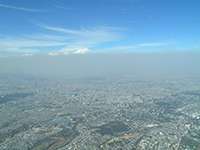New atmospheric modeling paradigm breaks previously accepted notions

(Phys.org) —Fortified with new evidence of particles' true disposition, scientists at Pacific Northwest National Laboratory developed a multi-dimensional modeling framework that predicts their formation and evolution in the atmosphere. Instead of treating secondary organic aerosols (SOAs), created by a mix of natural and human-caused emissions, as liquid-like volatile solutions as has traditionally been done, they modeled them as non-volatile semi-solids. The study is an important step in improving SOA modeling representations based on recent experimental findings of evaporation rates, diffusivity, and viscosity.
"Our work opens new frontiers in the field of secondary organic aerosols," said research lead Dr. Manish Shrivastava, an atmospheric scientist at PNNL. "In this study, we have taken the first step to improve the model's representation of secondary organic aerosols based on our new experimental findings of low volatility and high viscosity of secondary organic aerosols."
The haze over a city or the ash trail of a burning forest is visible evidence that something is in the air. But, tiny particles are in the air whether we see them or not. They affect climate, the weather, and human health. Biogenic sources, like trees and grasses, and anthropogenic sources from transportation and industrial activity release large amounts of gas-phase carbon-containing material. Their vapors chemically react when exposed to sunlight to form SOAs that often represent the dominant component of the tiny atmospheric particles in many parts of the world. Understanding their formation, properties, and the changes they experience as they travel through the atmosphere is necessary to predict and mitigate climate change and air quality.
The team applied state-of-the-art instrumentation and approaches to characterize properties of SOA particles in both laboratory and field settings. They showed that SOA particles are not at equilibrium as assumed by traditional models. Instead, researchers found the particles to be nearly non-volatile, and highly viscous. The team used both a box model and the three-dimensional Weather Research and Forecasting model with chemistry (WRF-Chem) to show that in this revised framework, semi-solid SOA particles do not evaporate when they are transported to cleaner environments, in sharp contrast to previous evaporating liquid SOA model formulations.
For the first time, the team expanded their model to include a multi-dimensional framework to represent the multi-generational aging of gas phase SOA precursors. This expansion added another dimension to explicitly track the different generations of gas-phase oxidation products that are changing due to a combination of functionalization and fragmentation reactions. After implementing the experimentally based, multi-dimensional framework in their comprehensive model they evaluated model predictions with aircraft measurements taken during the Megacity Initiative: Local and Global Research Observations (MILAGRO) 2006 field campaign over the Mexico City Plateau.
The new model formulation will be further evaluated with a much wider dataset of field measurements. The researchers are working to improve SOA model formulations and evaluate the implications of these findings in regional and global chemical transport models.
More information: Shrivastava, M. et al. 2013. Implications of Low Volatility SOA and Gas-phase Fragmentation Reactions on SOA Loadings and their Spatial and Temporal Evolution in the Atmosphere, Journal of Geophysical Research-Atmospheres, 118. DOI: 10.1002/jgrd.50160.
Journal information: Journal of Geophysical Research - Atmospheres
Provided by Pacific Northwest National Laboratory





















